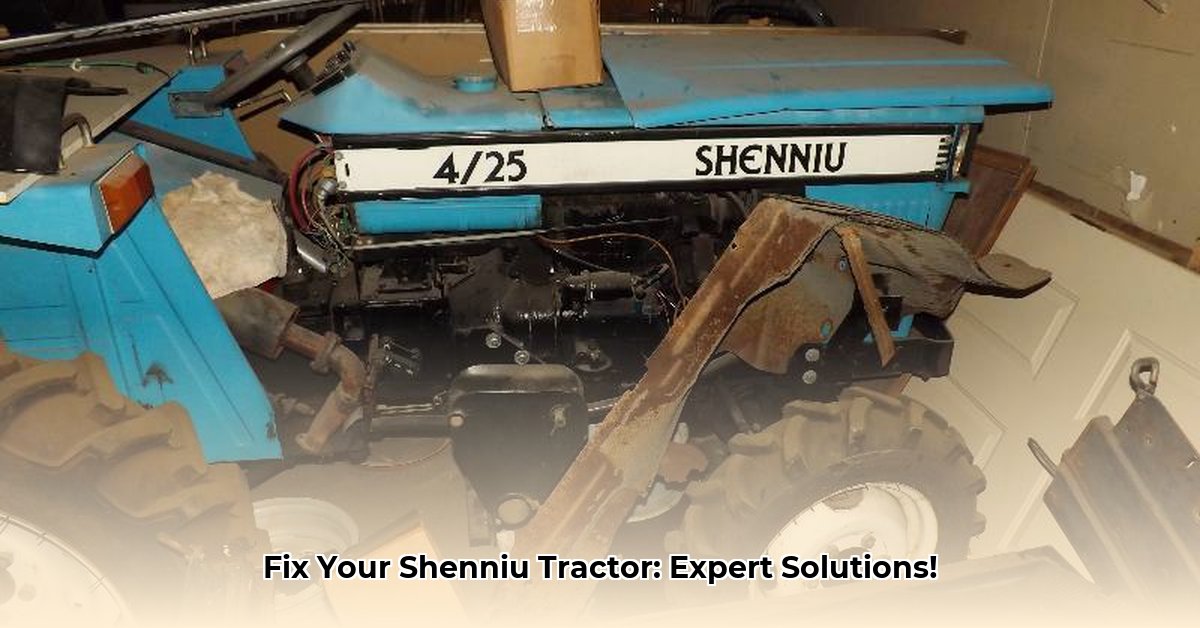
Shenniu Tractor 4/25: A Practical Guide to Troubleshooting, Maintenance, and Repair
This comprehensive guide addresses common Shenniu 4/25 tractor problems, offering practical solutions and preventative maintenance strategies. We'll dissect common issues, explore parts sourcing, and guide you toward finding qualified mechanics. This isn't just a review; it's your hands-on manual for maximizing your tractor's lifespan and ensuring smooth operation. For issues with other brands, check out this helpful resource on common tractor problems.
Understanding Your Shenniu 4/25: Strengths and Weaknesses
The Shenniu 4/25 tractor offers compelling advantages for small-scale farmers, primarily its affordability and compact size, ideal for navigating confined spaces. Its versatility, accommodating various attachments, further enhances its value. However, sourcing parts and finding knowledgeable mechanics can be challenging. Moreover, inadequate documentation often hinders troubleshooting. Addressing these weaknesses is crucial for maximizing your investment.
Troubleshooting Common Shenniu 4/25 Issues
Many Shenniu 4/25 problems are related to a lack of regular preventative maintenance. Addressing these proactively saves money and downtime in the long run. Let's tackle some common issues with step-by-step solutions.
Engine Troubles: Diagnosing and Resolving Performance Issues
Is your engine sputtering or refusing to start? Follow this sequence:
- Air Filter Inspection: A clogged air filter restricts airflow, impacting engine performance. Inspect and replace if necessary.
- Fuel Filter Inspection: Similar to the air filter, a dirty fuel filter impedes fuel flow. Inspect and replace if needed.
- Fuel Line Examination: Check fuel lines for cracks, leaks, or loose connections. Repair or replace damaged lines.
- Fuel Quality: Ensure you're using the manufacturer-recommended fuel type. Incorrect fuel can cause significant problems.
- Spark Plug Inspection (if applicable): Inspect spark plugs for wear or fouling, replacing them as needed.
- Seek Professional Help: If problems persist after addressing these steps, consult a qualified mechanic.
Brake System Problems: Ensuring Safe Operation
Brake malfunctions are a serious safety concern. Address them promptly.
- Brake Fluid Level Check: Low fluid indicates a leak, requiring immediate attention.
- Brake Fluid Condition: Discolored or contaminated fluid needs flushing and replacement.
- Brake Bleeding: If brakes feel spongy, bleeding the system might help. Consult a repair manual or mechanic if unsure.
- Professional Inspection: If bleeding doesn't solve the problem, a mechanic's expertise is needed.
Hydraulic System Issues: Identifying and Addressing Leaks
Hydraulic problems often require more specialized knowledge.
- Visual Inspection: Carefully examine all hydraulic hoses and connections for leaks, cracks, or loose fittings.
- Hydraulic Fluid Level: Check and top off as needed with the correct type and amount of fluid.
- Leak Repair: Locating and repairing hydraulic leaks can be challenging and may necessitate professional assistance.
- Professional Assistance: For persistent issues, seek professional help. This often involves specialized tools and expertise.
Preventative Maintenance: Prolonging Your Tractor's Lifespan
Preventative maintenance is key to avoiding major repairs. This simple checklist guides you. Remember, regular care significantly extends your tractor's operational life. Isn't that worth a bit of proactive effort?
| Task | Frequency | Notes |
|---|---|---|
| Oil Change | Every 50 hours (or as recommended) | Use only the specified oil type and quantity. |
| Filter Inspection/Replacement | Every 25 hours (or as recommended) | Air, fuel, and hydraulic filters should be replaced when necessary. |
| Fluid Level Checks | Before each use | Monitor engine oil, hydraulic fluid, coolant, and brake fluid levels. |
| Visual Inspection | Before each use | Inspect all hoses, belts, connections, and moving parts for damage. |
| Battery Check | Monthly | Ensure proper charge and terminal connections. |
Parts Sourcing: Finding Replacement Components
Locating Shenniu 4/25 parts may require some effort. Here are some viable strategies:
- Online Retailers: Search specialized agricultural equipment parts websites.
- Dealerships: Contact local dealerships; they may be able to order parts or provide leads.
- Used Parts: Consider used parts as a more economical option, but carefully assess their condition.
- Online Forums: Engage with online communities dedicated to Shenniu tractors; other owners might offer valuable sourcing information.
Finding Qualified Mechanics: Securing Expert Help
Finding a Shenniu 4/25-experienced mechanic can be challenging. Here are your best options:
- Word-of-Mouth: Ask fellow farmers for recommendations.
- Online Search: Use search engines and online directories to find agricultural equipment mechanics. Verify credentials and read reviews.
- Equipment Dealerships: Dealerships often have relationships with qualified mechanics.
Understanding Your Tractor's Limitations: Setting Realistic Expectations
The Shenniu 4/25 has limitations. Overloading or using it beyond its capabilities can lead to premature wear and potentially costly repairs. Operating it within its rated capacity is crucial for longevity.
Conclusion: Your Ongoing Journey with the Shenniu 4/25
This guide offers practical steps to address common Shenniu 4/25 problems. Preventative maintenance and proactive troubleshooting are vital for maximizing your tractor's lifespan and ensuring smooth operation. Remember, understanding your tractor's capabilities and limitations is paramount to your success.